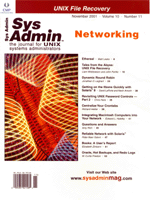 syslog syslog
The scope of the Internet is difficult to conceptualize, and attempts
to graph it are often too simplistic or too dry to capture my imagination.
I do admire the Internet map produced by Peacock Maps (http://www.peacockmaps.com)
based on work by Bill Cheswick and Hal Burch. They've now released
the 2001 version of this Internet poster that you may have seen at
trade shows or in magazines. Quoting the site, "It's a graph
of how the Internet might look if you were a packet of data like an
e-mail message. The lines show the paths you might take, network-by-network,
if you started at a computer in the U.S. and visited almost every
known network around the world. The lines branch at each network switch
or router along the way."
"The latest graph was made by recording the shortest path
taken by test messages sent on June 1, 2001, from a computer in
Murray Hill, New Jersey, to each of the 168,000 odd networks registered
in the routing databases kept by Merit Network Inc and other authoritative
sources. The data were then graphed using special software developed
by Hal Burch, while a Ph.D. student at Carnegie Mellon University,
and Bill Cheswick, while a scientist with an affiliate of Lucent
Technologies. Their research into large-scale network mapping is
now being applied commercially by Lumeta Corporation." The
map is rather mysterious and striking on the black background, and
the 01.01.00 version hangs in my office.
Mappa Mundi Magazine (http://mappa.mundi.net) also showcases
interesting maps in the "Map of the Month" section of
their site. As I write this (in September), the featured map is
"Map of the Market" from SmartMoney.com (http://www.smartmoney.com).
It's a cool conceptualization of the stock market that can
show daily stock prices for more than 500 publicly traded companies
at a glance.
More fascinating maps can be found at the Atlas of Cyberspaces
site (http://www.cybergeography.org/atlas/), maintained by
Martin Dodge. This site contains maps and graphic representations
of the Internet, the Web, and other cyberspaces, including information
spaces and multi-user dimensions. As stated on the Web site, "these
maps of Cyberspaces -- cybermaps -- help us visualize and
comprehend the new digital landscapes beyond our computer screen,
in the wires of the global communications networks and vast online
information resources. The cybermaps, like maps of the real world,
help us navigate the new information landscapes, as well being objects
of aesthetic interest." Atlas of Cyberspace is also
the title of a new book by Martin Dodge & Rob Kitchin, published
in August 2001 by Addison-Wesley. In the book, the authors explore
more than 30 years worth of maps depicting various cyber-landscapes.
Some of these maps are works of art that allow us to see the world
from a different perspective. As always, I welcome your comments
on this and other matters at: aankerholz@cmp.com.
Sincerely yours,
Amber Ankerholz
Editor in Chief
|

 syslog
syslog